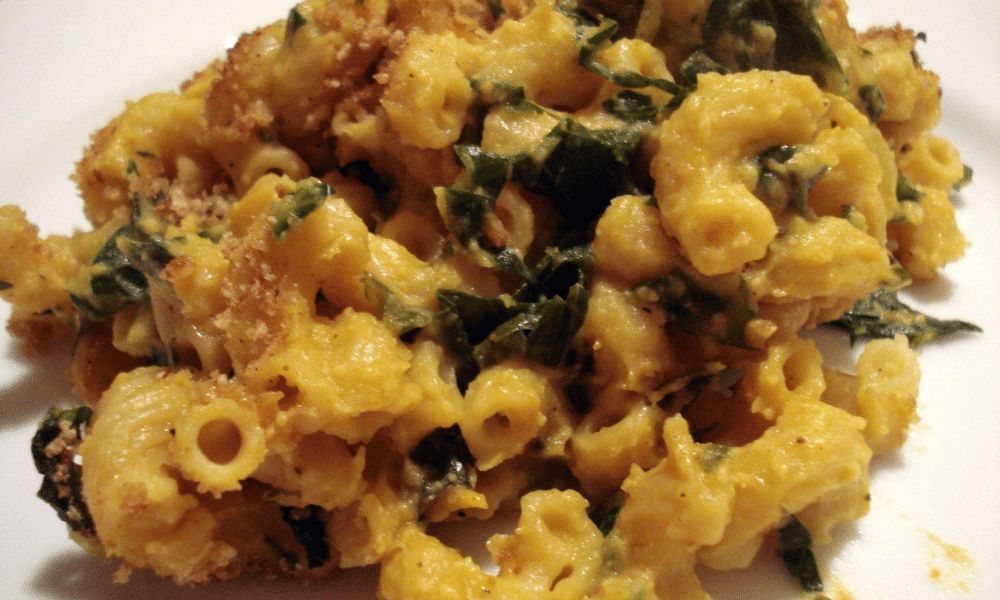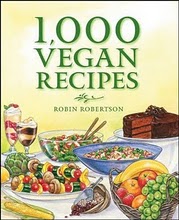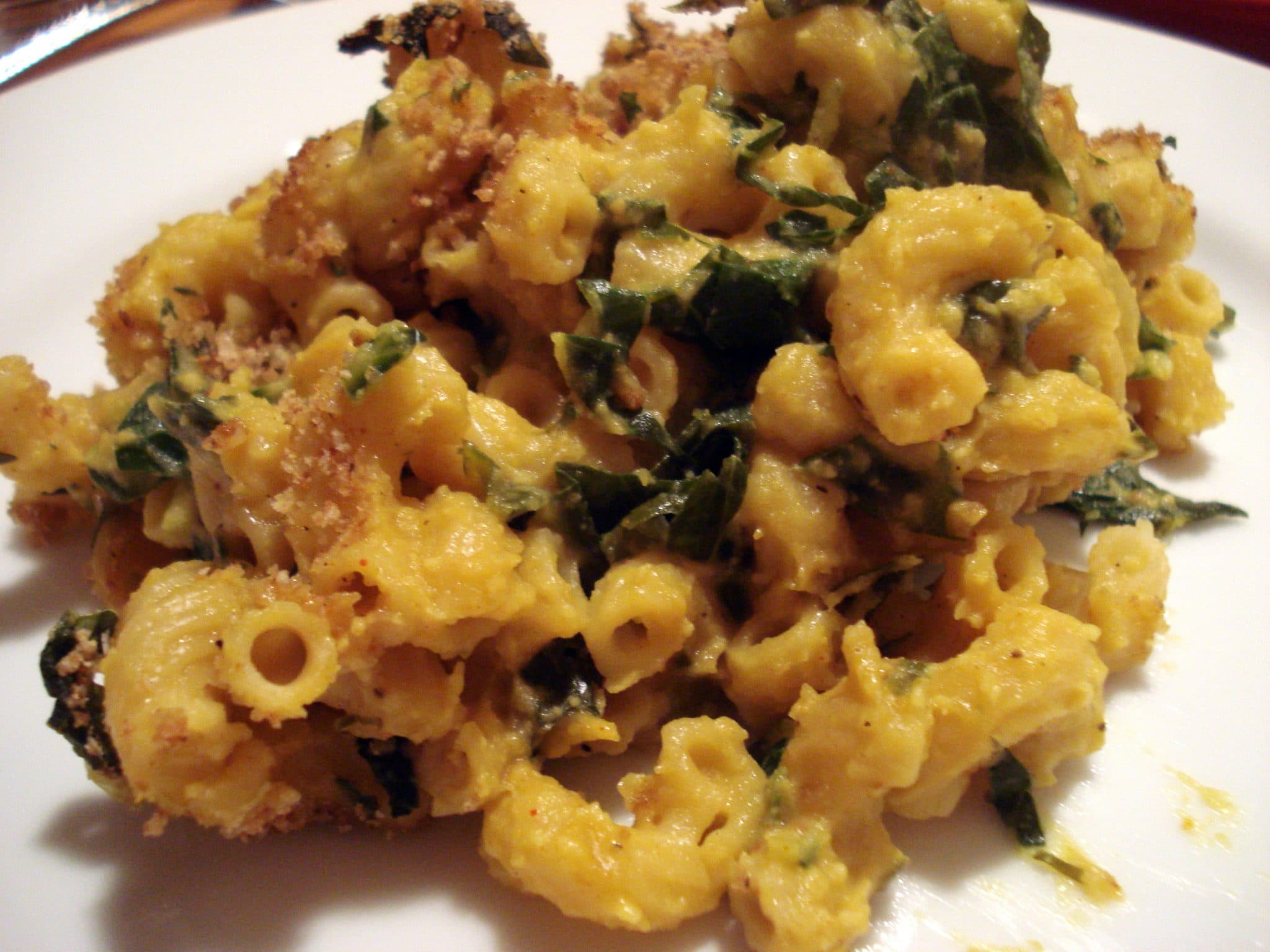
Robin Robertson interview
 As you know if you’ve been reading over the past few months, almost all of my recent cooking has been from Robin Robertson’s newest cookbook, 1,000 Vegan Recipes
As you know if you’ve been reading over the past few months, almost all of my recent cooking has been from Robin Robertson’s newest cookbook, 1,000 Vegan Recipes. Though I’m not a vegan, I recognize that vegan food represents a diet upgrade for me: I don’t like eggs, so the only non-vegan part of my diet is dairy, and I’m pretty well convinced that dairy does not do a body good. Thus far, I’ve found my foray into vegan cooking to be surprisingly effortless; much of that is owing to the diversity, if not the sheer number, of recipes in Robin’s cookbook.
Besides 1,000 Vegan Recipes, Robin has also written Vegan Planet and several other vegan and vegetarian cookbooks, so she certainly knows a thing or two about meatless meals. To find out more about her cooking philosophy (and to figure out how to start making vegan buffalo wings), I asked Robin a few questions.
Matt: 1,000 Vegan Recipes is the first vegan cookbook I ever purchased; what made me buy it was that as I was leafing through it, I saw loads of substantial meals that looked simple to prepare and didn’t rely on soy for the protein component. Do you think about nutrition when you create a new recipe, or are you just trying to make the best-tasting or most authentic meal possible?
Robin: When I develop a new recipe, I consider many factors, including taste, texture, and visual appeal, because if something doesn’t taste good or please the eye, no one will want to eat it, no matter how healthy it is. In terms of ethnic recipes, I try to balance authenticity with ease of preparation for the typical American home cook who may not have access to exotic ingredients or lots of time to spend in the kitchen. Nutritionally, I try to include lots of fresh produce and whole grains and I try not to use too much oil, but I do stress in the book that people who want to use even less oil can easily do so.
M: I like that when you talk about nutrition, you go right to “fresh produce and whole grains” rather than focusing on protein, carbs, and fat. But from a runner’s perspective, one has to at least pay attention to these, and protein is the big concern for a lot of people when they talk about vegan or vegetarian food for athletes. Soy is an easy way to get it, and even though most of your recipes don’t use soy products, there are plenty that do. (With 1,000 of them, I suppose this isn’t surprising.) What’s your feeling about cooking with soy; is it a last resort or have others been too quick to demonize it recently?
R: I love soy and I use tofu and soy milk regularly in my own cooking, although I don’t think one should eat a steady diet of any one ingredient. For those who may be allergic to soy, I provide alternate ingredient suggestions. If you look beyond that faction trying to demonize soy, you will find lots of sound level-headed nutritional and medical evidence to the contrary. Read The China Study by T. Colin Campbell, or read what Dr. Joel Fuhrman, Dr. Neal Barnard, or John Robbins have to say about the benefits of soy. Susan Havala and other nutrition experts, such as Dr. Mark Messina and Virginia Messina have written with great clarity on the subject as well.
M: I find that many of the best vegan and vegetarian meals are so good because they come from cultures that have historically eaten very few animal products, so there’s no need to adapt them. But every once in a while, it’s fun to have a vegan or vegetarian version of a favorite non-vegan or non-vegetarian meal. Is there a process that you go through when you sit down to come up with such an adaptation? For example, if you wanted to come up with a recipe for vegan buffalo chicken wings, how would you go about choosing what ingredients to use and how best to prepare it?
R: Most of the vegan recipes I’ve adapted from non-vegan classics have to do with mentally matching up taste, texture, and appearance. Once I do that, there are usually obvious choices of how to best prepare the dish. Sometimes seitan works best, other times beans, tofu, or even mushrooms can be used quite successfully. (For vegan Buffalo wings, I’d go with seitan.)
M: Were you a non-vegan cook before you became a vegan cook? What made you want to start doing strictly vegan recipes? Ethical reasons, health reasons, a new challenge?
R: I was a restaurant chef for years in mainstream restaurants. I went vegan for ethical reasons soon after I quit the restaurant business. I always loved animals and it never made sense to me that we should kill them and eat them. Once I quit cooking animal parts for a living, I was able to be true to myself and become vegan. Soon after, I began to help others go vegan through cooking classes and my writing, especially through my cookbooks, including Vegan Planet and 1,000 Vegan Recipes.
M: You’ve certainly helped me branch into vegan food! Even as a vegetarian, I thought vegan food had to be bland, or full of weird, processed substitute meats before I found your book. So now that you inspire so many vegan cooks, where do you turn for cooking inspiration?
R: Being a food professional for more than 25 years, my brain is tuned in for inspiration all the time. Traveling and eating in restaurants can be the most inspiring, but often it’s the ingredients themselves that inspire me. After a trip to the farmer’s market, I spread all the gorgeous produce on the counter in my kitchen and it’s like opening a treasure chest. The hardest part is deciding what to cook first.
You can read more of Robin’s writing and find some of her recipes at her blog, Vegan Planet.
Mac and Chard from 1,000 Vegan Recipes
To go along with the interview, I made Robin’s Mac and Chard, a vegan mac n’ cheese made without the use of soy or nutritional yeast, two ingredients that tend to turn non-vegans off. The cheese is replaced by a silky-smooth sauce made from dijon mustard, cashews, and pureed vegetables—not only does it look just like cheese sauce; it’s delicious and healthy too.
Here’s the recipe from 1,000 Vegan Recipes, by (of course) Robin Robertson and published by Wiley. (The grocery store didn’t have chard when I went; I used collard greens instead.)
Ingredients (makes 4 to 6 servings):
- 12 ounces elbow macaroni
- 1 medium bunch rainbow chard, tough stems removed and chopped
- 3 tablespoons olive oil
- 1/2 chopped yellow onion
- 1 garlic clove, chopped
- 1 medium Yukon Gold potato, peeled and cut into quarter-inch slices
- salt and freshly ground black pepper
- 2 cups vegetable broth, homemade or store bought
- 1/2 teaspoon turmeric
- 3/4 teaspoon sweet paprika
- 1/2 cup unsalted roasted cashews
- 1 tablespoon fresh lemon juice
- 1 teaspoon dijon mustard
- 1/2 cup dry bread crumbs
1. In a pot of boiling, salted water, cook the macaroni over medium-high heat until al dente, about 8 minutes. Drain well and set aside.
2. Steam the chard until tender, about 5 minutes. Set aside to cool. When cool enough to handle, squeeze any remaining moisture from the chard and set chard aside. Lightly oil a 9 x 13-inch baking dish and set aside. Preheat the oven to 350 degrees Fahrenheit.
3. In a large saucepan, heat 2 tablespoons of the oil over medium heat. Add the onion, garlic, and potato. Season with salt and pepper to taste, cover, and cook until the vegetables are softened, about 10 minutes. Add 1 cup of the broth, the turmeric, and 1/2 teaspoon of the paprika and continue cooking, uncovered, until the vegetables are very soft. Remove from the heat and set aside.
4. Grind the cashews in a high-speed blender until ground to a fine powder. Add the onion and potato mixture, the remaining broth, lemon juice, mustard, and salt and pepper to taste and blend until smooth. Taste, adjusting seasonings if necessary.
5. Combine the sauce with the cooked macaroni and steamed chard and transfer to the prepared casserole. Sprinkle with the bread crumbs and the remaining 1/4 teaspoon paprika and drizzle with the remaining 1 tablespoon of oil. Bake until hot and golden brown on top, about 30 minutes. Serve immediately.
Leave a Reply
That looks really yummy!! I’ll definitely be trying that recipe out sometime. I love a recipe that can incorporate something like chard with something tasty- like mac n’ cheese. Thanks for the recipe!
I’m interested in why you think dairy is not good to consume? As a vegetarian, I find dairy products a natural source of calcium and protein (obviously, everything in moderation)..
-
Chrissy, I stopped drinking milk when I became vegetarian because I learned how dairy is an acid-forming food, how no other species on the planet drinks milk after infancy or drinks the milk of another species, about some of the animal cruelty horrors of the dairy industry, and about stuff that gets into milk that comes from cows on factory farms. I never liked it that much anyway, so it was easy for me to substitute almond milk.
I do like cheese and other dairy a lot, but it is subject to the same problems as milk since it is made from milk (of course). I still eat it occasionally, but I try to avoid it when I can.
I’d love to hear a counterargument if you have one!
That mac’n chard looks amazing! Much healthier than other vegan mac’n cheese recipes I have seen. Yum 🙂
.-= Jessie (Vegan-minded)´s last blog ..Less-Guilt Brownies =-.
I recently purchased 3 new vegan cookbooks. I’m vegetarian, but not vegan. Like you, not an egg fan. I’ m really enjoying trying out some of the vegan recipes. I wish that there wasn’t a stigma associated with vegan or vegetarian b/c so many of the recipes would satisfy even the biggest meat eater!
.-= Heather (Where’s the Beach)´s last blog ..Sucky Saturday? I Think Not =-.
Not sure I could ever become a vegan as I am a huge egg fan. That having been said, great interview!!! The Mac N Chard looks fantastic. Chard is one of the veggies I grow.
.-= Nicki´s last blog ..Road Trip – Planning Begins =-.
Wow that mac n chard looks real creamy… I’d be interested to see how it tastes. Fun interview 🙂
.-= Heather @ Get Healthy With Heather´s last blog ..Hike: Iron Goal Trail =-.
Cool interview! I’d like to check out those articles about soy.
That looks so good! Even when I was vegan (recently added a couple things) I couldn’t stand using nutritional yeast and soy. Soy is really bad for your hormone balance.
Great interview! Vegan Planet is the first vegan cookbook I ever purchased and I am still working my way through it, there is so much to choose from! 🙂
.-= Sarah´s last blog ..Beginning and end =-.
That sounds like a great book and the recipe looks yummy. Thanks for doing the interview! I, too, am always looking for vegan recipes that DON’T rely as much on soy or hard-to-find ingredients.
What a great interview! 😀 And the meal looks fantastic! I’ve actually never cooked with chard—I take the spinach and kale routes most of the time because it’s usually more available.
We are vegans who are just getting back into running. It is so helpful to have runners blog about becoming a vegetarian/vegan. The protein issue is a bit of challenge and it really helps to know what does/doesn’t work for athletes. Thank you, No Meat Athlete!
We have a shelf full of vegetarian/vegan cookbooks, but we have been cooking from 1,000 Vegan Recipes almost exclusively for weeks. The range is amazing. Definitely check out Robin’s Vegan Fire & Spice, too. You will *never* associate “vegan” with bland again!
Excellent interview – We are looking forward to your posts!
Must go make some Mac & Chard. . .
-
Hi Nick and Nora, glad you guys found me! You would really enjoy Thrive; there’s a link to my review of it on the “Best of” page. It does a great job of explaining what athletes need to do to maximize energy from food.
I will check out the Fire and Spice recipe. I love spicy stuff! My wife, on the other hand…
Thank you for posting the mac and cheese recipe – my friend Tasha and I (blogger for Black Friday Vegetarian) and I decided to give it a try. It was the perfect fix to a very long week!!!!!
I also have Robin’s book that was a Christmas gift from my husband. We are not Vegans, but love vegetables and appreciate great tasting food. We love the book and cook something from it every week. I discovered last year I was lactose intolerant and didn’t know it, so I was looking for a way to learn to cook without dairy and keep the food good. This book is terrific.
This looks like a great recipe. I’m curious… can we substitute the cashews for chickpeas? My concern is the high fat content of this dish for those of us who are not runners. Thanks in advance for your reply!
I just made this for the first time. I am pretty impressed considering this is the first time I’ve eaten chard with any degree of success in my entire life! I have always hated greens of any kind, but they are something I know I need to try harder to eat. I felt this has a good comfort food factor and even though it doesn’t taste like cheese, the creamy sauce on the mac still has a flavor that I enjoyed. I think this dish deserves four and a half cows, although my reluctant veg husband say it only deserves two and a half cows. He managed to eat a plate of it, but his comment was, “I wouldn’t eat this by itself ever again. It might be a good side to have with a nice, juicy burger!”
Saw this recipe and HAD to try it! It seemed so much healthier than other vegan mac n “cheese” variations, but still looked delicious. Just took it out of the oven and I can confirm — it IS delicious!
So delicious have made it several times since I’ve printed it off… I’ve tried it with chard, spinach, and our family favorite broccoli, it is definitely a hit!!!
Do You have a cook book with no oils or fats.
Prefer something on the SOS diet, No added sugar, no oils whatsoever, and no added salt.
-
I have Robin’s 1,000 Vegan Recipes Cookbook and every dish I have tried has been wonderful! Although I have many vegan cookbooks, this one is my new favorite! Try Sweet Potato and Peanut Soup with Baby Spinach (page 158) made with Robin’s home made Veggie Broth (page 144), even my non vegan husband enjoyed it!





I also have her cookbook and so far everything I have cooked has been delicious! I will definitely have to try the mac-n-chard… Yummm! 🙂
.-= Aimee (I Tri To Be Me)´s last blog ..Swim, speed, sick =-.